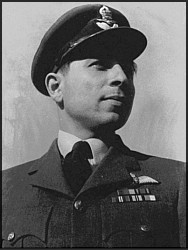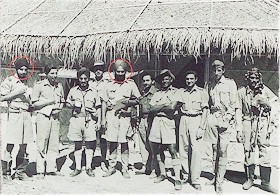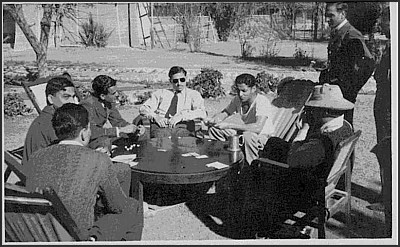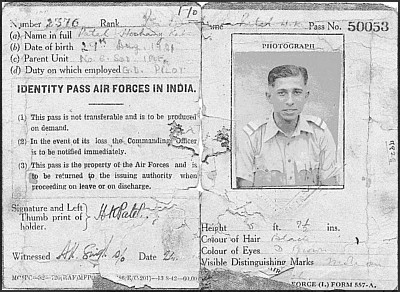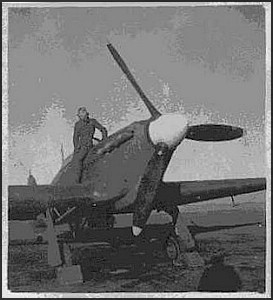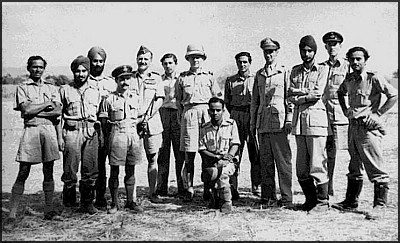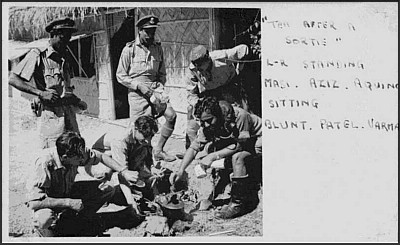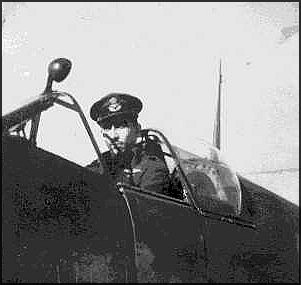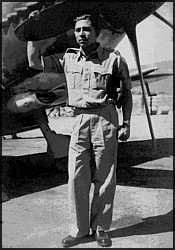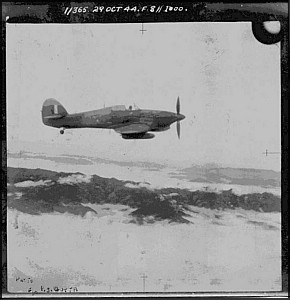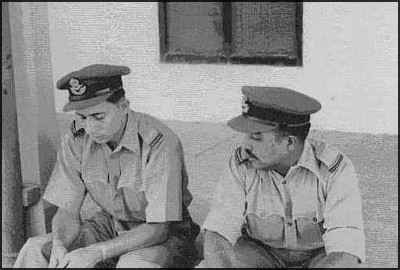A conversation with retired Wing Commander Hoshang K Patel in 2002 was what set us off on this path of chronicling the experiences of WW2 veterans.
CONVERSATIONS WITH WING COMMANDER HK PATEL (RETD)
Sometime in May 2002, I received an email pointing out several mistakes in our ‘No 1 Squadron in the Burma Operations 1941’ Photopage. The mail was from Wg Cdr Hoshang K Patel, a World War Two veteran who served with No.1 Squadron as an airman, before earning his commission and training as a pilot. Wg Cdr Patel communicated with us thru his son, Naushad who not only painstakingly clarified several of our queries, but also patiently scanned and rescanned several photographs from Wg Cdr Patel’s collection and emailed us regularly.
So when the opportunity came for us to visit Bombay, we just could not pass up a meeting with Wg Cdr Patel. We met Wg Cdr Hoshang Patel at his home in Pali Hill in Bombay on the 25th of August 2002. It was to be an introductory talk that would give us an idea about those days during World War Two. Naushad Patel, his son was there too. Also with us was Mukund Murty, family friend of the Patels. It was Mukund who first referred Wg Cdr Patel to visit the Bharat Rakshak Website.
Initially, we asked about some ops details in Burma and how he came into the IAF. We showed him a photograph of No.6 Squadron from the IAF book ‘Sentinels of the Sky,’ which had only two members identified in the photograph – Sqn Ldr Mehar Singh and Flt Lt M S Pujji. Wg Cdr Patel was able to identify all but two of the members in this particular photograph. He had only one comment on the publishers of that book “Why couldn’t they have asked someone like us for the names or any other information – we could have advised them!”
There was another picture in the ‘Sentinels’ book that purported to show a group of Indian airmen with a Lysander of 1 Squadron. Wg Cdr Patel stated that he was quite sure that the photograph was not of No.1 Squadron at all. Wg Cdr Patel shared with us some names from the first tour of 1 Sqn. In Dec. ‘41/ Feb ‘42, like Deuskar and Dhora (who were killed when their Lysander overturned on landing), Raza and Rajendra Singh. There were a good number of people from Bombay who served with the Squadron.
Interview at the time of Joining the IAF –
Wg Cdr Patel recollected the days when he joined the Indian Air Force. His primary education was in a village school in Nargol, Gujarat from where he went on to college in Bombay. Good conversational English was a prerequisite before joining the Indian Air Force as an Officer. Since he was poor in this when he was called for the interview, he was told that he may not get into the IAF as an Officer. Without much deliberation, Wg Cdr Patel asked to join the IAF as an Airman. Flt Lt Aspy Engineer who was on the interview board, dissuaded him from Joining. The story is continued in Wg Cdr Patel’s own words:
Sqn Ldr Mukerjee was the head of the Interview board at that time. Flt Lt Aspy Engineer was also there in the interview and he said, “Hoshang, don’t join the ranks, Parsi boys from Bombay cant take the tough life there”. Meanwhile a skinny Malayali corporal came to him for some signature or something. After he left I asked, “Who is that man?” “He’s corporal so and so..” was the answer.
I said to them “Will you ask him to wrestle me, run 100 yards dash, or a 1 mile race with me? I will beat him in all, and I mean it!”
“So You still insist on joining?” said Aspy.
I said “yes”
“You promise never to blame me? Because all the Parsi boys who have signed up are blaming me saying that I promised them heaven,” asked Aspy
I agreed – and I found myself in the ranks in the Indian Air Force.
Airman Training
From the day I joined I started building up on my English – for this was the reason that I could not apply as an Officer in the Indian Air Force. First I managed to get a small pocket dictionary and later, any literature that I could think of. Read, read, read, pronunciations, meanings, subtleties, differences in meanings, and gradually I came up in my knowledge of English. So much so that before I could leave that School, a British Flying Officer (or Flt Lt) called me aside and said “Why dont you apply for pilot training”. I said ” I will never get selected” “But why?” so I told him why. “I am a reject so far as they are concerned”. So for the sake of that I joined No 1 Squadron, which Sqn Ldr KK ‘Jumbo’ Majumdar was commanding. We went to Burma to do our tour of ops,
Operations at Toungoo, Burma 1942
When we were in Toungoo, We were being bombed from morning to evening virtually every few minutes by the Japanese. And the mess was blown up. So we were stuck to our Barracks all around. Out of the Squadron strength of about 200-250 odd people, there were about 15 or 16 Parsi’s. They were the rowdiest crowd that you can think of.
Crying Wankadia
There was a chappie named Wankadia. Every time there was a raid, you know, he laid shivering in the trench and crying away like hell. Literally crying! And then, during any break in the bombing, people had to go to the airfield to service the aircraft. The Lizzies were not flying, but we still had to look after them and service them. The RAF operated Brewster Buffaloes on the same field on the other side.
The American Volunteer Group, which became the Flying Tigers, under General Chennault was also there. Chennault became the air chief of the Chinese air force during that period. Very interesting person. He married a Chinese woman also if I know rightly. He was very fond of the Chinese and China. But I think he was in the army-air force reserve or he had just retired or something like that, when the war broke out.
So anyway, Wankadia was working on an aircraft and the bombing started. So as usual he jumped into the trench nearest to his aircraft and started crying like hell. Nearby, an aircraft of No.28 RAF Squadron virtually got a direct hit. An RAF ammunition mechanic who was working there got hurt very badly and was shouting for help. So Wankadia, still crying, ran to the aircraft amidst the falling bombs, hauled him out, dragged him to the trench and resumed his crying.
When the story about “Crying Wankadia’s gallantry” spread, people started asking him as to why he cried when he was actually so brave. He said “You think I am afraid for myself? I am a married man, I’ve got a child, I am worried about them. What will happen to them if I am gone? I’m scared of that, not (for) myself! “
Friendship with Niranjan Prasad
One of the well-known personalities in Post Independence Indian Military History was Maj Gen Niranjan Prasad. Maj Gen Prasad was the divisional commander at NEFA before the Chinese offensive in October 62. It is not well known that Maj Gen Prasad also served as a pilot in WW2 with the Indian Air Force, even commanding No.8 Squadron in battle. Wg Cdr Patel was a good friend of Niranjan Prasad right from his first tour of operations flying Lysanders in Burma.
“Officer Airman relationship was very good when I was in Burma with No.1 Squadron. For example, Niranjan Prasad was shot down once. He baled out and he had either fractured or dislocated his ankle. Either he was shot down or was it engine failure – I don’t know. There is an interesting story here. After Niranjan Prasad baled out of his Lysander, he landed in a Burmese farmer’s field. The farmer graciously gave him rice wine and his daughter fed him Khao Shwe. Next day Prasad returned to Toungoo, much more exhausted than when he left!
Niranjan Prasad was completely immobile at that time when he came back to Toungoo. That was the first time I met him. I remember that he was one of the first courses of the Indian Military Academy. If he felt like it he would wear the Army uniform with army ranks, or sometimes he would wear the air force uniform as a Flt Lt. And he was not the only one. Pakistan Air chief Asghar Khan, he was also from the Army. Flt Lt DAR Nanda was from the Army; he ultimately retired as an Air Vice Marshal. So there were quite a few Army chaps who had opted during the war to come to the Air force, went thru flying-training and flew with us. And Niranjan Prasad even commanded a Squadron (No.8) in operations. Niranjan Prasad went back to the army because he fell out with the British chief. And to the best of my knowledge he was the only man in the allied armed forces who was a Captain when the war started, and was back as a Captain again when the war ended. But what a dear, dear person he was. He had his limitations, and he got on the wrong side of the people in the army also. He was blamed for the debacle at NEFA, when actually the people to be blamed are Pandit Nehru, Krishna Menon, the CBI chief and Gen Kaul. Those are the people who have to be blamed. We all get too wise too late and, I am sorry to say, Prime Minister Nehru had no time to receive any professional advice.
So, coming back to my story, when Niranjan Prasad got shot down, people went to work and he was left alone except for the cook. So I said “Sir anything that I can do?” He said, “Whatever you can”. So I used to get up early, help him to the toilet, wash, change, polish his shoes, and he became so sentimental about it saying “Please don’t , please don’t. You don’t have to do everything”. I said ” An army jawan would have done that as your batman” I said “. So what, if I do it!” Only after he was comfortable would I take a truck and join the rest of the crowd at the airfield.
He never forgot that.
After that we met quite a few times. Once, when he had already left the Air Force and gone back to the army as Captain, as luck would have it, I was commanding a flight in Miranshah in 1944 as a Flying Officer. By coincidence, Niranjan Prasad happened to be my Ground Liaison Officer (GLO). This was when I was in No. 7 Squadron. I told my boys, “From today onwards, you will address him as Sir – not as Niranjan”. He said “No, you cant. You don’t have to call me that”. I said “Tomorrow if you become Major, I will have to call you Sir. Moreover, I have never called you by your first name – ever! This is the first time we are meeting after the Burma Operations and its my privilege to call you Sir.”
Niranjan received it very nicely. He did become a Major later when I was still in Miranshah. Then we parted company and then met again in the National Defence Academy, I was Squadron Leader and he was a Major General, Commanding the Indian Military Academy, which was the military wing of the National Defence Academy. There were two wings at that time, both located at Dehradun. One was at Clement Town – that was the Joint Services Wing. And this one was called the Military wing. It was a marriage of convenience at the time. And then when the National Defence Academy buildings came out in Poona and moved out, it again reverted to Indian Military Academy. I was commanding the ‘Fox’ Squadron at NDA.”
Wg Cdr Patel’s path with Maj Gen Prasad was to cross again, this time in much darker and tumultuous times – during the 1962 India-China war. That episode is narrated at the end of this series.
Naked running in Bombing raids.
One of the anecdotes that was much heard about but never put down anywhere in writing was the story of two erk’s who ran naked during a Japanese Bombing raid – all to win a bet.
“In addition to the rowdy Parsi crowd, one of the people to join 1 Squadron was a Gujarati of all people. He name was Agha. Agha was foolhardy, just like a Parsi. He was known as “Green Gujarati”. So during the air raid, one chap named Elavia went up to Agha and said “Agha, If you can run from this trench, completely naked, to that barrack over there and come back while a bombing raid is on, I will give you two annas.”.
Agha said “You do that, and I will give you Four annas”. Elavia agreed
“My turn first” said Elavia. Before he stripped he said “You know I am a Parsi, I cant remove my sadra and kusti”. Agha said “Alright then hold up your sadra while you are running so everyone can see everything!”
So Elavia had to agree. He raced from the trench to the barrack and back, completely naked except for his held-up sadra, and jumped into the trench
Now Agha said “My turn”. The bombing is still going on. Agha strips himself completely to the skin, then starts walking about casually, and wanders to an adjacent trench where there was a senior man, a Sikh chap crying away. So he puts one leg on one side of the trench and the other on the one side and says, “Arre Sardarji, Aap rote hai?” The Sikh says “Are tumhay maut ke liye sharam nahin hai? Nikal yaha se!” So he carried on and, equally casually, he strolled back and jumped on Elavia “Now you give me my two Annas”
They were an absolutely mad crowd. I bumped into him (Agha) only once after he retired, Elavia went to Australia and I believe he died over there.
Every time there was a raid, the Parsi boys used to sing, you know, the mouth organ, playing and all in the trench, and behaving completely undisciplined. But when it came to work, they worked. So when Squadron leader Majumdar, he brought the Lysander Squadron from Bombay, thanked Bombay for giving them the aircraft, he made a reference on All India Radio. He said “Yes..Rather a rowdy bunch, but they were extremely good for morale. Nothing, but nothing, will stop them from singing, and playing their mouth organs, and clapping, shouting, laughing.“
Finally when the Squadron moved back from Toungoo all Lysanders, except for three, had been handed over to the Burmese Air Force. Air Commodore Homi Ratnagar, who is now settled in Secunderabad, has confirmed this.”
Sometime in Mid ‘42, the Illustrated Weekly of India brought out an issue on No.1, with the cover showing an illustration of a Lysander taking off dramatically between bombs and shelling. The cover was entitled “last aircraft out of Burma” and was said to be a photograph of Raza’s Lysander.
Call for Flying Training
Even though he had missed out getting selected as an Officer, HK Patel got another chance soon after returning from the first tour.
After the operations the Squadron came back, first to Secunderabad. Here Sqn Ldr Mukherjee took over. One day he looked at me and said, “I seem to have met you before!” I kept quiet – I did not tell him about our meeting at the Airmen selection Interview.
The Squadron then moved to Trichnopoly and about that time they had put down on the daily routine orders that “all those people who want to fly can put in your applications”. So many people applied that they decided to interview everybody. The requirement was for twelve people but they interviewed twenty-five.
When my turn came up to be interviewed, it was during working hours. I was in my overalls, my hands were dirty and I had just seen an aircraft off. So they saw me like this, sat me down and grilled me “you have come dressed like this?” “I have just seen off an aircraft and…” I didn’t have a watch but I was looking at the time and said “… and I have to receive another aircraft in another twenty minutes time”. So They asked some questions to which I replied formally. The questions were technical, about flying, what you would do under certain circumstances, etc etc.
The Second Interview
Not soon afterwards HK Patel would be called out for a second interview – as it turned out, a very crucial one. For this was to be the turning point in his career. Wg Cdr Patel continues his narration:
And then there was a second interview. This time, the second interview was after working hours, so I went properly dressed .
And the first thing I saw was that Niranjan Prasad was on the board along with Lala Rupchand, our first ambassador to Afghanistan, then a Flt Lt – Adjutant. His father has taken a promise from everyone not to allow him to fly. The Squadron Commander and Lala Rupchand were both very good old friends. But still, he was not allowed to fly. Poor chap, he didn’t even know his left from right when it came to marching – he was that naïve!
I remember the time while we were in Toungoo where we were being bombarded for nearly twelve hours in a day. I had to go to their HQ for some work and while i was getting out, he (Rup Chand) comes following me and plaintively asks “Patel, whats going to happen?”. Airfield was bombed, morale was absolutely low. I said “Don’t worry sir, our day will come”. He says “My God, you are brave aren’t’ you?” He didn’t know that even I was shivering down my back.
So anyway, in the interview, the first thing that Niranjan Prasad says is “Ah, so you have come properly dressed!” I said “Sir, Its after duty hours”. And they asked me various questions.
One question was “Supposing you are still flying Lysanders, you are in an area where there is no aviation fuel and you have a service-able aircraft. Will you let the serviceable aircraft use vehicle fuel?”
I said, “yes, I would, under certain provisions”.
He says “What provisions?”
I said, “For every gallon of vehicle fuel, I would use a pint of engine oil.”
“Why on earth would you do that?” They themselves didn’t know why.
I said, “Motor fuel is highly explosive. You want a fuel that has got a slower burning process. M.T. fuel would backfire or blow inside the engine. So in order to cut down the combustion rate, you have to add oil, because there is no other additive available”
“And you would do this?”
“If its a case of life and death, why not?”
Then they started asking me questions on various other things; somehow I gave the proper replies. Mukherjee says, “Supposing you are not selected this time, what would be your reaction?”
I said “none at all, “
“You wont be disappointed?”
I said No.
“Why?”
“Because I feel I wont be selected. I know this because there are several people who are at a marginal age level, 26-27, if they don’t get a chance today, plus they are people known to you. There are air gunners, wireless operators, You know…. I think they have a priority. And there is a need too”
“Then why did you apply?”
I said, “I didn’t apply – you called me, but I didn’t apply”. And I started to get up.
“No we haven’t finished with the interview – Sit down”
Some more questions were put, and then the Interview finished. I smartly saluted and left.
It turned out that on the list of 25, my name was the last. Instead of the twelve needed, they selected thirteen people. Mine was the thirteenth name in that list.
The first Identity card held by Wg Cdr HK Patel immediately after completion of Officer training. The photograph shows him as a Flight Cadet from 1942. Anyway there was still a time lag before I went for flight training. By that time Calcutta had been bombed, Madras was in danger, and something or the other happened. And there was a blockade. So I had to wait for nearly six months before the call came out.
During which time I was doing my advanced course on airframes as a mechanic at Ambala. They were still on Hurricanes, Wapitis and Audaxes. Even then I had already come from a Lysander Squadron, they had still not changed the course. But this advanced course was really advanced. It did not matter which airframe or which engine. “
Wg Cdr Patel then reported for flying training afterwards. Soon he was commissioned with Service No. 2376 and reported to No.6 Squadron in the Arakan Operations.
Completion of Training and No.6 Squadron
Wg Cdr Patel was selected for flying training and, on completion, was posted to No.6 Squadron IAF during the Arakan Campaign under Squadron Leader ‘Baba’ Mehar Singh. After No. 6 Squadron completed its tour of duty and pulled out of the operational area, Wg Cdr Patel got posted to No.1 Squadron to complete his tour of operations. His final posting during partition was with No.7 Squadron, ‘The Battle Axes’.
JC Verma’s memorable combat.
No account of No.6 Squadron can be narrated without mentioning JC Verma’s air combat ‘kill’ against the a Japanese Oscar fighter on 15 Feb 44. During some hectic manoeuvring, one of the Oscars flew across Verma’s gun sight. Without thinking or aiming, he pressed the gun button, bringing the Oscar down! The confirmation came a couple of days later, when the army confirmed that the Oscar had gone down. It was Wg Cdr Patel who helped ‘Bandy’ Verma write his combat report after he shot down the Oscar. Verma at that time was too shaken by his narrow escape to write anything! He had just seen his wingman Bhattacharjea get shot down, and he himself had faced many harrowing moments before he extricated himself from the situation.
During the battle, Verma’s wingman, Bhattacharjea was hit by bullets from the Oscars whilst he was haring it back for base at low level, and he blacked out with the pain and shock. In a one in a million chance, the Hurricane crash-landed on its belly all by itself. Bhattacharjea, who was badly wounded, survived, although he suffered further injuries in the crash and went into a coma.
An Indian forward unit, which came that way, rescued Bhattacharjea. He was extremely badly injured and not expected to live much longer. They bundled him up in some blankets and left him to die in a hut. A few days later a medical officer visited the forward unit and found Bhattacharjea, surprisingly, still alive with good return pulse etc, but covered in maggots. Though it was not known to them at the time, the maggots actually helped heal Bhattacharjea’s injuries much faster because they would normally eat away the infection and toxins from the wounds. The Medical Officer asked the unit commander to build a katcha airstrip for a small ambulance aircraft to airlift him to a larger airfield. When Bhattacharjea had recovered enough for the doctors to find him an encouraging prospect for survival, he was put on the next Dakota for evacuation to rear lines.
Bhattacharjea was in a deep coma all this time, and was totally unaware of what had happened to him. While the Dakota was making its flight out of the area, Japanese Oscars attacked it! As the lumbering transport was weaving and turning to escape the Japanese fighters, Bhattacharjea very briefly regained consciousness from his coma, to see that Oscars were attacking his aircraft – again – before he slid mercifully back into oblivion. Somehow, the Dakota managed to shake off its pursuers and Bhattacharjea went to Jorhat military hospital where he remained till he recovered consciousness 6 weeks later.
Murkot Ramunny
One member of 6 Squadron who was a close friend of Wg Cdr Patel was Murkot Ramunny. Described as an ‘avid flier’, Ramunny flew at every chance he could get. Ramunny was quite short (about 5 feet!) and he had difficulty in landing a Hurricane properly as he could not reach the rudder pedals. Ramunny quit the IAF after the war and joined the Indian Frontier Service (Equiv of IAS in the North East). After a distinguished career in the North-East, he retired to his hometown in Kerala at Telicherry. Murkot Ramunny has authored a book on his World War Two flying days ‘The Sky was the Limit’. Even though 87 years old, Ramunny is an avid writer and still takes part in various social activities.
Mehar Singh
The CO, Mehar Singh, was another great flier with the Squadron. But Mehar Singh held a dim view of any flier who was not British or Sikh. So neither Wg Cdr Patel nor Murkot Ramunny could get along too well with their CO! But there was no questioning Mehar Singh’s courage or flying skills. Wg Cdr Patel recollected one incident in which a Hurricane was force-landed in a field with major damage.
“I remember that the pilot of this Hurricane had a big hole shot through his wing, and finding it difficult to get back to base he made a forced landing on a makeshift landing-ground within our lines. Sqn Ldr Mehar Singh brought the aircraft back to base after stuffing the hole with materials like gunny-bags, bed sheets etc. It was indeed heroic because there was really no way to repair the machine where it was.”
Mehar Singh’s command of the Squadron was so distinguished that it was recognised by an award of a Distinguished Service Order (DSO), the only DSO ever awarded to an Indian Pilot. Wg Cdr Patel was with the Squadron when Air Marshal Baldwin presented the DSO to Mehar Singh during a visit to the squadron on the frontline. Mehar Singh later became AOC Operations Group and conducted the operations during the 1947-48 War earning the Maha Vir Chakra (MVC). Mehar Singh did not last long in the IAF after the war. Even though he had a good record, he ran into personality clashes with several officers in the command and put in his papers soon after.
Wg Cdr Patel offered his recollections at other members of No.6 Squadron.
“There were several ‘notables’ with No.6 Squadron at that time. Flt Lt MS Pujji was one of the Flight commanders. The Other Flight commanders included Flt Lt Nazirullah Khan and Flt Lt Shivdev Singh. Later Flt Lt Hassan took Pujji’s place.
Then there was Fg Offr Bhullar who was shot down and captured by the Japanese. He later joined the INA of Subhash Chandra Bose. Bhullar survived the fighting and at the end of the war, like many others, he rejoined the IAF. I believe he retired as Group Captain. . I next met him at Jodhpur station after the war. The Japs also shot down Nair. I understand Nair was tortured because he refused to cooperate with his interrogators and refused to join the INA. Fortunately he also survived and rejoined the IAF. Subsequently he left the IAF (story goes he was asked to leave).
All of us referred to each others by Nicknames. Besides “Baba” for Mehar Singh and “Creamy” for Blunt. Massilamani was “Massie” (pronounced Messy), Aziz Khan was “Ausie” and yours truly was “Pat”. JC Verma was known as “Bandy”. We had a small group of technical tradesmen of the RAF attached to the squadron and out technical officer was also an RAF officer. His name was Hawkins but he was commonly called ‘Titch’ Hawkin because he was a very short person.”
When, No.6 was withdrawn from Operations, Wg Cdr Patel was posted to No.1 Squadron on the Burma front to finish his tour of Ops. On completion of his tour of ops, the third unit with which Wg Cdr Patel served was No.7 Squadron at Miranshah/Peshawar/Kohat
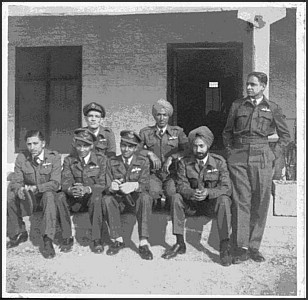 |
Fg Offr HK Patel with members of No.1 Squadron at Kohat in 1945. Known names in the photo : Top Row Sitting – Stitson and P/O Dilbagh Singh. Bottom Row Sitting – HK Patel, ?,?,?. |
The Hawker Hurricane
Wg Cdr Patel spent some time recollecting about the various aircraft he flew or encountered during his tour of operations. The Hawker Hurricane was the mainstay of the IAF Squadrons that saw action on the Burma Front. Wg Cdr Patel recollects:
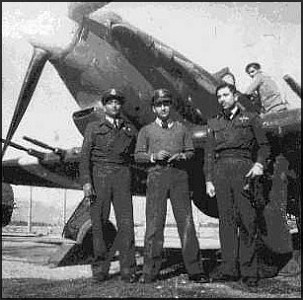 |
|
| Hawker Hurricane of No.1 Squadron at Kohat. Fg Offr Patel is standing on the right. Standing in the center is Kapur, who later became the DGCA. | |
“The Hurricanes were good for visual and photographic reconnaissance but not upto par as a fighter against the Japanese Oscars and Zeros. Doing reconnaissance involved flying at “not more that 50ft AGL”, simultaneously keeping an eye open for possible targets, jotting notes down on your kneepad etc – not exactly something easy to do! Even the RAF Hurricane Sqns (eg No. 28) were not fighter, but recce squadron. In a way, we did get an inferior aircraft in the Hurricane. Witness to this is the fact that we got our Spitfires only towards the end of the war. So we had to make do with what we had.”
“We shouldn’t forget that the Hurricane was the main strength of the RAF during the Battle of Britain. Spitfires are tops during daytime, Hurricanes at night. Spitfires couldn’t fly at night because of its glowing exhausts. Coming into land in the dark the exhausts used to be so blind the pilot that they ultimately had to put shrouds over the exhaust pipes to kill the glow. Beaufighters also accounted for a hell lot of a number of night kills after the Battle of Britain, because they had the Radar Intercept – very elementary, but results came. The Germans did not know – They said because they ate carrots, the eyesight of the Royal Air Force Beaufighter pilots, like John Cunningham, became so good.
Why were the Indian Squadrons like Nos 1, 4 and 6 Sqns given the fighter-reconnaissance role, and other IAF units were given fighter-bomber roles,Was there a sense that these were easier roles for the IAF, as compared to the fighter role, which seemed to be the prerogative of the RAF Units? Was it a case of having necessarily to use the Hurricanes, and the RAF not being inclined to give Spitfires to the IAF? Wg Cdr Patel has this to say:
“There was no question of an easier role for Indian Pilots. The Hurricanes were good for visual and photographic reconnaissance but were not unto par as a fighter against the Japanese Oscar and Zero fighters. Doing reconnaissance involved flying at “not more that 50ft AGL”, and simultaneously casting an eye around for possible targets etc and also jotting notes down on your kneepad. Not exactly something easy to do! Even the RAF Hurricane Sqns (eg No. 28) was not a fighter, but a recce squadron.
In a sense, we did get inferior aircraft. Witness that fact that we got our Spitfires only towards the end of the war. So we had to make do with what we had.”
Flying the ‘Tank Buster’
Among the versions flown by Wg Cdr Patel was a Hurricane IID in early 1944. This aircraft belonged to an RAF Unit and was one of two that were to be ferried from a satellite airfield near Cox Bazar to Chittagong airfield. The Hurri IID was as good and a docile aircraft as the IIC but was inevitably heavier due to the presence of the two 40mm guns. The extra weight required larger braking distances as Wg Cdr Patel found out.
Chittagong at the time was a tricky approach, one had to dodge many barrage balloon as well as the Cranes at the port before the approaching pilot had to make a sharp turn over the river for final. The runway strip was also quite short and was made up of gunnybags and tar! Hoshang managed to bring down the aircraft in the first approach while the wingman, KG Bhimrao had to go around and come in for a second approach. This time, Bhimrao also made it safely to the ground.
Henry Runganadhan’s Crash
Command of the No.1 Squadron after Subroto Mukerjee was taken over by Sqn Ldr Henry Runganadhan. Henry as he was known hailed from a very distinguished family. Trained in the UK, he was a terrific aerobatic flyer. He was earlier a Flight commander with No.3 Squadron. However his stint with No.1 Squadron did not last long. Henry Runganadhan died while travelling as a passenger in a Lockheed Hudson.
“In the case of Henry Runganadhan, the young pilot involved in the ramming was flying a Hurricane. And flying over the Desert on a long cross-country leg, Hurricanes had no navigational facilities. No High Frequency Range Finders, no useable instruments till you came within the R/T Range of your airfield. Quite a few airfields did not even have the homing beacons. So normally in such cases a smaller aircraft follows the bigger aircraft, which have the navigational facilities.
After having dropped-off an aircraft, Runganadhan was returning to base from Karachi. He got a lift from Karachi in a Hudson flown by an RAF chap. And during that flight it is very likely that the Hurricane pilot who was following the larger aircraft suffered a temporary or momentary epileptic fit at that time, and rammed into the Hudson’s tail, chewing up its control surfaces. Everyone in the Hudson went down.
The younger pilot’s Hurricane was also damaged badly. His blades were gone and he came back and made a belly landing. If I recall rightly, this pilot could not recall anything about the collision. Henry Runganadhan was a super flier. He may have had his faults, but he was a superb flier. His wife later on married an Air Force Doctor. That Air Force Doctor’s elder brother retired as a General (Shrinagesh).
As for the young pilot who was flying the Hurricane, he still doesn’t know what may have caused it. From a Pilot Officer or a Flying Officer, till he became an Air Commodore, nobody knew that he was prone to epilepsy. Perhaps he didn’t himself know till very late in life.”
Mid Air Collision at Miranshah
Wg Cdr Patel himself was involved in a narrow escape once. He was flying a Spitfire XIV at Miranshah during his stint with No.7 Squadron when another Spitfire XIV that was trying to formate came up from the rear and chewed off his tail controls. This happened on 25 Oct 1946.
“I really don’t blame the pilot who was involved in the Hudson collision. I blame the leadership – like the time I had my Spitfire tail chewed off. The person who was leading the formation took a wrong decision. Normally we all took turns in leading the formation. We planned the patterns, the take off patterns, how we would form up, how we will break formation etc. But this time the leader of the formation said “whoever is closest to me will formate with me first”. I said ‘you are asking for trouble’. He said no planning. I said it was a blind corner – “you are asking for disaster”. I stand by it.
Then we took off. First part went all right. Formation broke off, and I was number two to him. And I was a little behind, so I pulled up and formated with him. Mohoney, poor chap, he was lower and a little further away and he didn’t see that I had already formated. He was keeping an eye on the leader and trying to pull up into position and he never saw that I was already there. And he pulled up and chewed my tail up.
I don’t know what happened to him as I saw him only on return, but I went into a shallow dive. I said to myself, tail is all chewed up and there will be no control so I tried to open the Hood – and the Hood jammed. So there was still time and I said, No. I think I can control it. So I pulled out, reduced speed and managed to come back and land. The bottom half of the rudder and the complete right elevator were chewed off totally. I had only half a rudder and an elevator.
And then I see Mohoney already on the ground. The first thing we did was hug each other and then I laid down flat on the ground and kissed mother earth! All the five blades of Mohoney’s Spitfire were half their size, all the five blades! But we were close to the airfield, so we made it back. The collision happened at about 4000-5000 feet AGL.
Flying Officer Mohoney, later on the poor chap died in a Tata airlines crash. There was no Indian Airlines at that time. With one Captain Zaria Khan as his second pilot.”
Fortunately both HK Patel’s Spitfire [RN-199] as well as Mohoney’s aircraft [RN-221] were only damaged and not written off. Incidentally Spitfire RN-199 did not survive much longer after the incident. Put back into the air after repairs, it was destroyed in a crash on 21 Feb 47, when Fg Offr Ahmed hit a boundary wall coming into land at Kohat.
TB Scare
There’s another very funny story. I was visiting the Hospital in Ambala for a re-check. At that time Shrinagesh was our medical officer in the school of technical training in Ambala. I was examined again and he put me in a place where there were suspect tuberculosis cases. A day after that I broke down in his presence “Am I suffering from TB that you have put me in this ward?” TB at that time was incurable, you see. He said “Oh you are back?” Immediately I was shifted. Reason was that there were a couple of people who pretended to be suffering from TB there also. One of them was an old friend of Air Marshal Engineer, who joined the ranks and kept on blaming AM Engineer that he “promised me the earth” and he pretended that he was suffering from TB.
Reminiscences about Old and Bold fliers
There were a number of legendary names that Wg Cdr HK Patel encountered during his service in the Second World War. Time and space constraints limit us to document his reminiscences about the DFC Winners and close friends.
Jumbo Majumdar DFC and Bar
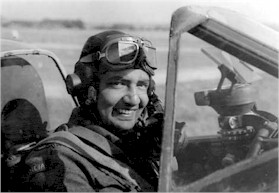 Wg Cdr Patel served under Jumbo Majumdar during his tour of operations with No.1 Squadron. Jumbo was awarded the DFC for his tour of ops in Burma. The DFC was specific to an incident in which he discovered an enemy airfield and later led operations against it. Jumbo was to subsequently receive a Bar to his DFC. The circumstances on his second DFC were quite unusual. It was always a matter of curiousity for us as to why Jumbo Majumdar went to Europe to do a second tour of Ops and served under a Squadron Leader in a RAF Recce Unit.
Wg Cdr Patel served under Jumbo Majumdar during his tour of operations with No.1 Squadron. Jumbo was awarded the DFC for his tour of ops in Burma. The DFC was specific to an incident in which he discovered an enemy airfield and later led operations against it. Jumbo was to subsequently receive a Bar to his DFC. The circumstances on his second DFC were quite unusual. It was always a matter of curiousity for us as to why Jumbo Majumdar went to Europe to do a second tour of Ops and served under a Squadron Leader in a RAF Recce Unit.
Wing Commander HK Patel, has a very interesting anecdote on this query of ours:
When Jumbo was promoted to Wg Cdr he initially refused to take this rank over Mukerjee who was still a Sqn Ldr. I was in Secunderabad when Mukerjee personally flew down there to meet Jumbo who was commanding No.1. Mukerjee persuaded Jumbo to accept the promotion . He said he would be extremely proud if Jumbo did so. Jumbo eventually accepted and took on the rank. Please note that this (Majumdar’s Wg Cdr Rank) was an acting rank.
After this promotion Jumbo was posted to AHQ Delhi where apparently the Brit C-in-C Air Forces in India (I dont recall his name) made some kind of disparaging remark about how Jumbo got his DFC. This upset Jumbo to the extent that he immediately asked for a return to his substantive rank, and asked for a transfer to Europe so that he could prove his worth (and as the story went in those days, he additionally told this gent that under the circumstances he found it difficult to serve under him). Which is probably why Jumbo arrived in Europe as a Sqn Ldr and not a Wg Cdr.
Aspy Engineer’s DFC:
Aspy Engineer was flying in Baluchistan at the time and there were constant skirmishes with tribesmen. In this particular case an Army detachment had been trapped and had run out of ammo, and he flew over them at this particular time.
So Aspy signals the Ground. Did they want anything? Was all OK?. If everything was all right that was one signal, if they wanted ammunition that was another signal, if they wanted medical aid that was something else. The crew read, “We are short of ammunition”. At that time the .303 was the standard weapon for Rifles, for Machine guns as well as the machine guns in the aircraft. So he ordered the chappie in the back, with the gun, “Remove all your ammunition and take off your socks,” and he took off his socks as well. They stuffed the aircraft ammunition in their stockings (in those days you used to fly in stockings and shorts, no flying overalls), and dropped their ammunition to the troops below, thus saving the day. For this he got the DFC.
Then Narendra, I don’t think he commanded a squadron in Burma like you mentioned in your page. Just check. At least not on the Burma front. Aspy never flew in Burma.
Squadron Leader Prithipal Singh. – This incident was really in Miranshah. With the Wapitis..or Audaxes, I dont know for sure… This is the story that I heard. It happened when they were loading the bombs onto the wing racks. And one bomb, while still being fixed on the rack just came down. People ran helter-skelter waiting for it to go off but he just stood there. (He) Called them back. “Put it there”. He was a fine officer. A little hoity-toity, uppish and all that. Again, he was a Cranwell trainee. But he was a good flier. And sometimes good fliers. they get killed. And lousy ones like me survive
P S Gupta is one chappie who didn’t even know that he had got the DFC. He died on the very day that it was announced. Very handsome boy, very handsome boy. The Squadron was moving out at that time. He, along with Flt Lt H N Chatterjee DFC, the Flight Commander, Squadron Leader Rajaram, all took off and got lost in clouds. There was no turning back because there was no more fuel left at the airfield. They were completely evacuating Manipur. And he got into clouds, probably got disoriented and crashed thereafter.
See, even when you are flying light aircraft you normally don’t go by instruments alone. It’s only on Multi Engine aircraft or fighter aircraft that you have to learn and to practice. But how the hell can you practice during war? And you’ve got to learn not only to interpret but also to rely on your instruments. You can’t fly in bad weather by the seat of your pants. For example the diffused light of the sun is here (indicating 2 O Clock on vertical plane), but your natural instinct is to think that the sun should be in this position (indicating 12 O Clock) so you turn (bank) right to correct. That’s the end of it. Because of the refraction in the cloud. you cant see anything outside. You don’t realise where the sun position is. You must maintain your attitude. So if you turn to get the sun on top of you or in front of you, you try to follow your instinct instead of your instruments, it never works out.
K N Kak got his DFC in No.1 Squadron; Minoo Bulsara got it in No.1 Squadron. Bulsara was a good flier, and throughout the operations he had an incident free record, a good flier, a good observer to bring back information. Because you see now, we were cooperating with the Army. Our main job was to locate the enemy, sometimes locate your own troops, rather than fight. And sometimes when you have a target, shoot it up.
M S Pujji, Pujji got his DFC in an earlier squadron although he was in 6 Squadron. Somehow he was one of the few Sikhs who could not get along with Mehar Singh. He was a Sardar but both could not get along. It’s like two Parsi’s. There’s a saying “Parsi tari arsi”. It means that when two Parsi’s meet they fight; and when a Parsi is alone, he looks into the mirror and fights with himself!
Shitoley, Surendra, Chatterjee all got their DFCs with 1 Sqn.
Minoo – I don’t recall but I think he got his with 4 Squadron.
They don’t come much better than Ronnie Engineer. Ronnie was a superb, absolutely superb natural born flier, a superb leader, a superb friend, and a superb comrade. Later on he had to leave the Air Force, because one of his squadron commanders, leading a formation of Canberras to attack Karachi, came back without completing the mission. Jettisoned his bombs en-route. This was in the 65 war. He was station commander at Poona at that time. Ronnie was made the scapegoat – scapegoat in the sense that it’s the commander who ultimately takes the rap.
H D Barucha, who got his AFC, got it when he was with the Royal Air Force. D F Eduljee who got the AFC died in operations. He was an instructor. and as an instructor, he got an AFC. I remember his death; he was making multiple passes at a ground target. During one of them he was coming out of a roll quite close to the ground, misjudged it and flew straight in.
I am not in touch with Ramunny, he must be in his late 80s. He was a dear friend of mine. Absolutely a gentleman par excellence. Both Cecil Naire and Ramunny left around the same time. They never met because normally one took over from the other. And both of them were in different areas. When one was in the Arabian Sea, the other one was in Nagaland. That sort of thing. Cecil Naire spoke English like an Englishman , French like a Frenchman. He was a B. Sc from the Travancore University. He used to teach Physics, Chemistry and Maths to the science students, and English and French to the Arts students. And till the last day in the Air Force he had a lien on that job. But he accepted Permanent Commission and gave up that job. I have lost touch with him. He was probably contracting Alzheimers when I met him last in Calicut in ‘95.”
Just before we broke off for lunch, we went thru the photograph collection of Wg Cdr Patel, which had some rare and excellent pictures from the WW2 era. Wg Cdr Patel also showed us a rare WW2 publication on the Indian Air Force which can be classified as a rare collector’s item. That publication was an historian’s delight, with photographs of IAF DFC awardees and photographs from the front-line – it was probably published just after WW2.
Predicting Ayub Khan’s future
Wg Cdr Patel mentioned an anecdote from that time where he met Mohammad Ayub Khan, who would later become President of Pakistan and the self-appointed Field Marshal of the Pakistani Army.
An Army formation in NWFP had requested the presence of an IAF officer for Air Force liaison work at a brigade-level exercise . As the designated officer could not, or did not want to make it there, Fg Offr Patel was asked to report for the exercises. He arrived at the Officers’ Mess to find it totally deserted. In walked Lt Col (acting rank) Md Ayub Khan, who was flabbergasted to see that the Air Force had actually sent an officer for the exercises! They had been so used to having their requests ignored all this time that they did not expect Fg Offr Patel to actually arrive!! Within a short while, it was abundantly clear that both had sruck an instant rapport. During the course of the conversation, Fg Offr Patel mentioned that he had some knowledge and interest in palmistry, Ayub Khan could not resist extending his hand to find out about his future, and asked Fg Offr Patel to examine his ‘future’ and tell him what was in store for him.
Patel looked at Ayub Khan’s hand , looked up and told him “I can tell that one day you will be King.”. Patel continued, “Not only become a King, but you will also get dethroned!”. This statement would have some interesting repercussions later!
It so happened that at the Brigade-level exercises, Ayub Khan’s battalion out-performed the other two battalions of the Brigade. Both the other two Lt Col’s had to face a dressing-down from the Brigade commander on their poor showing. The Brigadier then praised Ayub for his good show and congratulated him. Apparently, when Patel also congratulated Ayub and mentioned the word of praise from the Brigadier, Ayub responded saying that he didn’t trust the Brigadier and that he would back-stab Ayub at the first opportunity he got!
After a few months, Fg Offr Patel was at another exercise, when a loud voice hailed him from behind ” HEY YOU!”. Patel turned back and immediately recognized him as Ayub Khan. Ayub Khan growled at Patel “Aren’t you the one who told me that one day I would be a KING?” . When Patel saw Ayub Khan’s badges of rank, he instantly realised the irony of his prediction – Ayub Khan was wearing the crowns of a major – one rank below what he had held during their previous meetings! Patel’s second prediction of Ayub being dethroned had already occurred!.
What exactly had happened? The brigade commander, while praising Ayub Khan in front of the British Lt Cols, had done exactly as Ayub had predicted. Ayub Khan had never taken leave in his four years of wartime service. He was asked to go for the maximum amount of leave ( 48 days?) that could be availed at that time and when he came back from that leave, he was shocked to find a British Lt Col sitting in his chair at battalion HQ.
When Ayub was on leave, since there was a rule that no one holding an acting rank could hold it for more than a specified amount of time which was exceeded by the period of leave that Ayub had availed. Another Lt Col was bought in as CO and the Brigadier covered up Ayub’s demotion by saying he wanted a good officer like Ayub as a Brigade Major at his HQ!
Later Ayub Khan was to become the Chief of the Pakistani Army and later the President of Pakistan. The the ‘prediction’ had finally come true. Wg Cdr Patel never did contact Ayub Khan after he became President, though he recollects rather wistfully that he should have written to Ayub Khan reminding him of their earlier encounter.
Injured in a Spitfire Crash
When we broke off for lunch at a nearby restaurant, the discussions continued on his stint with No.7 Squadron. Wg Cdr Patel was still a Flying Officer in May 1947, when he had another crash while flying a Spitfire XIV on a cross-country from Miranshah to Karachi. The crash landing resulted in multiple injuries. Because of the main head injury, there is not much that Wg Cdr Patel remembers other than taking off. What he does remember is that that particular aircraft had abnormally high fuel consumption, and that he had aborted the flight the day before for that very reason. On the day of the crash, he had not carried a map, had run short of fuel (ironically not too far from the airfield) and had attempted a belly landing in a field.
The book Spitfire International records this crash as having occurred on 22nd May 1947 involving Spitfire XIV Serialled RN-220. The cause of the accident is given as fuel starvation and subsequent belly landing at Shikarpur
It was about the time he was in Hospital, that the CO of NO.7 Sqn Ldr Madan Lal Mishra died in a jeep accident. Sqn Ldr Mishra (See Kuriyan’s ‘Partition Troubles‘) was known for his drinking and partying. While the Squadron pilots were speeding in a jeep after a late night binge to celebrate the return of another injured pilot back on duty, the jeep overturned injuring several officers and killing Sqn Ldr Mishra.
Due to the injuries from the Spitfire crash, Wg Cdr Patel missed going with 7 Squadron on the J and K Ops in 1948 under Masillamani. Wg Cdr Patel later went to the JSW in Dehradun, the precursor to the NDA.
